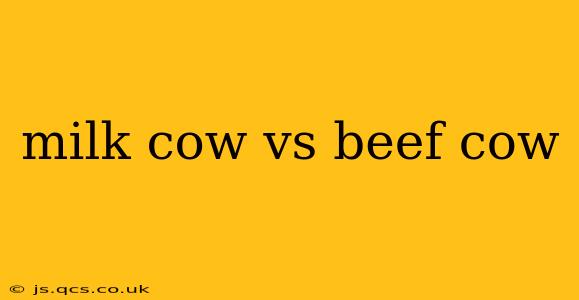Choosing between a milk cow and a beef cow depends entirely on your goals. Are you looking to produce milk for your family or a potential dairy operation? Or are you focused on raising cattle for meat? Understanding the key distinctions between these two types of cows is crucial for making an informed decision. This comprehensive guide will explore the significant differences in breed, genetics, body composition, and overall care.
What is the difference between a milk cow and a beef cow?
The most fundamental difference lies in their primary purpose: milk production versus meat production. This distinction shapes nearly every aspect of their biology, breeding, and management. Milk cows, also known as dairy cows, are selectively bred for high milk yields, while beef cows are bred for efficient meat production, focusing on muscle mass and growth rate.
What are the different breeds of milk cows and beef cows?
There's a wide variety within both categories. Let's explore some popular examples:
Milk Cow Breeds:
- Holstein Friesian: Known for their high milk production and distinctive black and white markings. They are the most prevalent dairy breed globally.
- Jersey: Smaller than Holsteins, Jerseys produce milk with a higher butterfat and protein content.
- Guernsey: Similar to Jerseys, Guernseys are known for their rich, golden milk.
- Brown Swiss: A larger breed known for its high milk production and longevity.
Beef Cow Breeds:
- Angus: A popular breed known for its marbling (fat distribution within the muscle), resulting in tender and flavorful meat. They are typically black.
- Hereford: Recognizable by their red and white markings, Herefords are known for their hardiness and adaptability.
- Simmental: A large, dual-purpose breed that can be used for both beef and milk production, though primarily focused on beef.
- Charolais: A large, muscular breed known for its rapid growth rate and lean meat.
What is the difference in body composition between milk and beef cows?
The physical differences are striking:
- Milk Cows: Typically leaner in build, with larger udders designed for efficient milk production. Their body structure prioritizes udder capacity and milk synthesis over muscle mass.
- Beef Cows: Heavier and more muscular, with a body composition designed for maximizing meat yield. They have a larger frame and a higher proportion of muscle to fat compared to dairy cows.
How much milk does a milk cow produce?
Milk production varies greatly depending on breed, genetics, nutrition, and management practices. A high-producing Holstein cow can yield upwards of 30 liters (8 gallons) of milk per day, while other breeds might produce less. Factors like age and lactation stage also significantly influence output.
How long does a milk cow produce milk?
A dairy cow typically has a lactation period of approximately 10 months after giving birth to a calf. After that, there is a dry period before the cow calves again and begins lactating anew.
What are the nutritional needs of milk cows versus beef cows?
The diets of milk and beef cows differ significantly to meet their contrasting physiological demands:
- Milk Cows: Require a diet rich in energy and nutrients to support high milk production. This often includes specialized feed formulations containing high levels of protein, carbohydrates, and essential minerals.
- Beef Cows: While still needing a balanced diet, the focus is on energy for growth and muscle development. They may consume more forage (grass, hay) compared to dairy cows.
Are milk cows good for meat?
While not as efficient for meat production as beef cows, milk cows can be slaughtered for meat after their productive lactation years end. However, the meat quality might differ, often being leaner and less marbled than beef from specifically bred beef cattle.
What are the overall care requirements for milk cows vs. beef cows?
Both types of cattle need regular care, including:
- Housing and shelter: Protection from harsh weather conditions.
- Health care: Regular veterinary checkups, vaccinations, and parasite control.
- Feeding and nutrition: Appropriate diets tailored to their specific needs.
- Breeding and reproduction: Management of breeding cycles to maximize productivity.
However, the intensity and specifics of care will vary depending on the cow's purpose. Dairy cows require more frequent milking and meticulous udder care. Beef cows' management focuses on efficient growth and health maintenance.
In conclusion, the choice between a milk cow and a beef cow hinges on your priorities. If you need a consistent milk supply, a dairy cow is the clear choice. If you're aiming for meat production, a beef cow is more suitable. Understanding the inherent differences in breed, body composition, nutritional needs, and care requirements is crucial for successful cattle farming.
